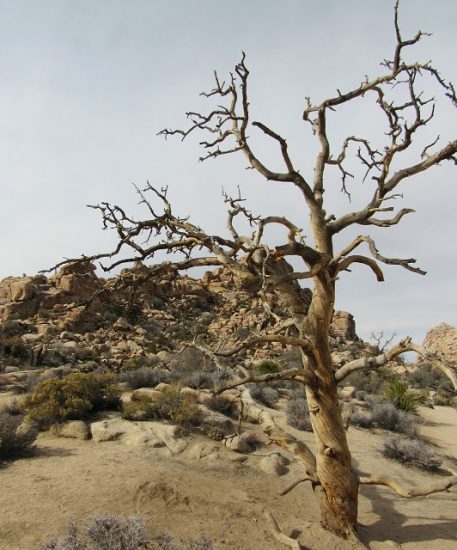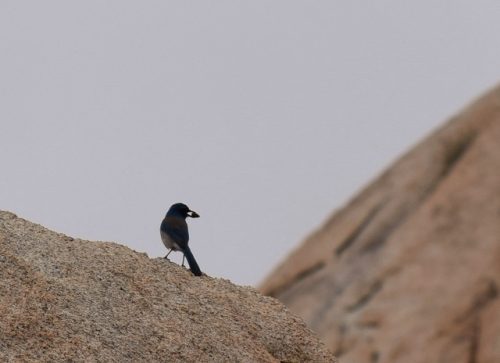Day 2: December 6, 2015
Keys View
First thing in the morning I drove up to Keys View – a viewpoint within the park that offers 360 views of the desert and several unique features. Palm Springs and the Coachella Valley are visible below, and I got a great view of the Salton Sea in the distance. Smog often conceals the view of Mexico, but the wind must have blown the smog away that morning, because I was able to see Signal Mountain, about 95 miles away, across the border to Mexico. It was a great view!

The view of the Coachella Valley

The Salton Sea, with Signal Mountain – 95 miles away in Mexico – in the top, distant center.
It was really cold though – the wind and exposed location made me glad that I had brought my hat and gloves! Winter in the desert can be cold, especially at higher elevations, and it wasn’t even a particularly cold day!
Lost Horse Mine – 4 miles RT
The Lost Horse Mine is aptly named. In 1890, Johnny Lang and his father brought their cattle to the Lost Horse Valley for grazing. One night, their horses disappeared, and they were able to track them to near the Keys Ranch, where they had a run-in with the McHaney Brothers, suspected cattle rustlers. The McHaneys told them their horses weren’t there.

Looking down on the Lost Horse Mine Trail.
Along the way, Lang made the acquaintance of another man, who had discovered gold in the area, but was afraid to develop the mine because of threats by the McHaneys. He sold his claim to Lang, who acquired three partners to offer protection, and started developing the mine. He purchased a two stamp mill, hauled it up the hill, and set up a line to bring steam up the hill to power the mine. The work was difficult; due to the remoteness of the site, a road had to be built to haul all the materials through several miles of undeveloped desert.

Mining Equipment at the Lost Horse Mine.
Unlike many other mines in the area, the Lost Horse mine was very successful. Eventually, Lang partnered with a Montana businessman, who brought a larger ten stamp mill to the site. Of course, at some point he realized that Johnny Lang was skimming profits off the top, as the day shift and the night shift were producing very different amounts of gold. He gave Lang the option to either be bought out or go to jail. Lang chose the buy-out, and kept prospecting nearby, until he died of exposure one winter. His body wasn’t found for a couple of months, and then was buried near Keys View Drive.

Some sort of gears overlooking the Lost Horse Mine.
The Lost Horse Mine produced more than 10,000 ounces of gold and 16,000 of silver, more than $5 million in today’s dollars, over its lifetime. Not too shabby!

The head frame of the Lost Horse Mine.
The hike is an out and back, two miles uphill on the way out and downhill on the way back. It is a moderate hike, with views of the valley and a recent forest fire, as well as rock foundation ruins of various cabins and outbuildings in the area.

The view from the Lost Horse Mine
The mine threatened to cave in several years ago; the National Park Service tried a new innovative technique that involved filling the mine shafts with polyurethane foam, and then covering the foam with fill dirt to prevent it from disintegrating in the sun. They also built a new head frame over the main entrance to the mine. Despite all this however, the mine is still unstable, so there is a fence around the main entrance to prevent people from walking too close to the shaft.

The head frame of the Lost Horse Mine.
After checking out the mine, I also hiked up to the top of the hill for a 360 view of the surrounding area. It was beautiful! I saw a small, orange butterfly there as well, he was such a pretty little guy! On the return hike I saw a small lizard, the only one I saw during my trip. Most of the reptiles in the park are in a state of hibernation in winter, so it isn’t typical to see them unless the temperatures are sufficiently warm.

A butterfly at the Lost Horse Mine.

A lizard on the Lost Horse Mine Trail.
After the Lost Horse Mine, I drove over to the boundary where the Mojave Desert meets the Colorado Desert. Near this spot is a place where the habitat is perfect for a type of cactus, the Teddy Bear Cholla. The name is misleading though, as the cholla is covered in thousands of tiny, hair-like spines that will quickly attach and then embed themselves under your skin, making for a very painful experience. This one area of the park has a “garden” of hundreds of cholla, making it look like they were intentionally planted here.

Teddy Bear Cholla
The walk in the cholla garden is not rigorous, and gives visitors a good overview of how these cacti grow and reproduce. There are even birds that love to nest in the cholla, because the spines give them protection from predators! A short distance away from the cholla garden, the desert provides habitat for ocotillo, a succulent that has long thin leaves stretching high over my head. These plants can appear dead for much of the year, coming back to life and blooming after a rain.

Ocotillo
My evening included a trip for more pho; this time at the Red Lotus in Twenty-Nine Palms. It was kind of fun to compare the pho at each place. I liked the broth at the Yucca Valley pho restaurant better, but I liked the meat better here. It was a good end to another good day.





























